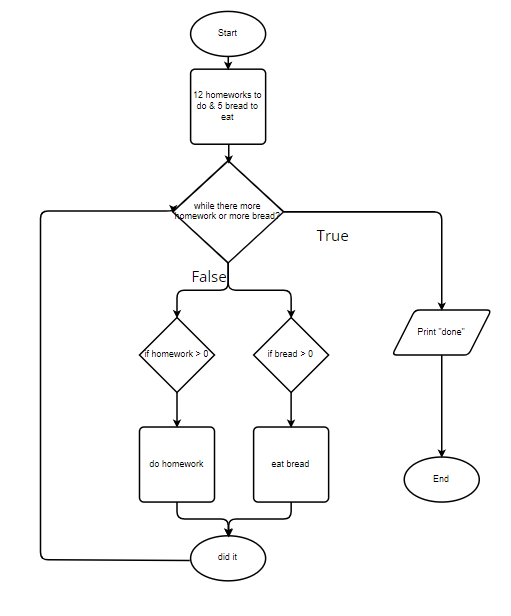Unit 3.9 & 3.11 Hacks
Hacks
3.9.1
- why is it important to know that algorithms that look different can do the same thing and that algorithms that look the same might have different results?(0.15)
- It is important to know that algorithms look different and that algorithms that look the same may have different results because when they look the same, a small difference can make it wrong. Also with different algorithms, it can do the same. It is important because I know that there are many ways to make an algorithm and I need to be careful when making algorithms.
- for the converted conditional to boolean conversion(0.10)
isInedible = False
isLiquid = True
if isInedible == True:
print("Don't drink it")
else:
if isLiquid == True:
print("Drink it")
else:
print("Don't drink it")
isInedible = False
isLiquid = True
drinkTime = not(isInedible) and isLiquid
if drinkTime == False:
print("Don't drink it")
if drinkTime == True:
print("Drink it")
3.9.2
Develop your own complex algorithm using a flowchart and natural language, then code it!

- Start
- There are 12 homeworks and 5 breads
- Repeat following steps 4-5 until there is no more bread or homework
- If there is more than one homework, do a homework
- If there is more than one bread, eat a bread
- Print done when finished
- Finish
homework = 12
bread = 5
while (homework or bread) > 0:
if homework > 0:
homework -= 1
if bread > 0:
bread -= 1
print("Homework left:",homework,"\nBread left:",bread)
import random
#sets variables for the game
num_guesses = 0
user_guess = -1
upper_bound = 100
lower_bound = 0
#generates a random number
number = random.randint(0,100)
# print(number) #for testing purposes
print(f"I'm thinking of a number between 0 and 100.")
#Write a function that gets a guess from the user using input()
def guess():
num = input("What number?")
#add something here
return num #add something here
#Change the print statements to give feedback on whether the player guessed too high or too low
def search(number, guess):
global lower_bound, upper_bound
if int(guess) < int(number):
print("Too low") #change this
lower_bound = guess
return lower_bound, upper_bound
elif int(guess) > int(number):
print("Too high") #change this
upper_bound = guess
return lower_bound, upper_bound
else:
upper_bound, lower_bound = guess, guess
return lower_bound, upper_bound
while user_guess != number:
user_guess = guess()
num_guesses += 1
print(f"You guessed {user_guess}.")
lower_bound, upper_bound = search(number, user_guess)
if int(upper_bound) == int(number):
break
else:
print(f"Guess a number between {lower_bound} and {upper_bound}.")
print(f"You guessed the number in {num_guesses} guesses!")
3.11
- calculate the middle index and create a binary tree for each of these lists
- 12, 14, 43, 57, 79, 80, 99
- 92, 43, 74, 66, 30, 12, 1
- 7, 13, 96, 111, 33, 84, 60
- BELOW
- Using one of the sets of numbers from the question above, what would be the second number looked at in a binary search if the number is more than the middle number?
- Set 1: 80, Set 2: 74, Set 3: 96
-
Which of the following lists can NOT a binary search be used in order to find a targeted value?
a. ["amy", "beverly", "christian", "devin"]
b. [-1, 2, 6, 9, 19]
c. [3, 2, 8, 12, 99]
d. ["xylophone", "snowman", "snake", "doorbell", "author"]
- C because it is unsorted
numListOne = [12,14,44,57,79,80,99]
numListTwo = [92,43,74,66,30,12,1]
numListThree = [7,13,96,111,33,84,60]
numLists = [numListOne, numListTwo, numListThree]
for x in range(len(numLists)):
numLists[x].sort()
middle = int(len(numLists[x])/2)
print("Middle Index of List #",x+1,"is",numLists[x][middle])



